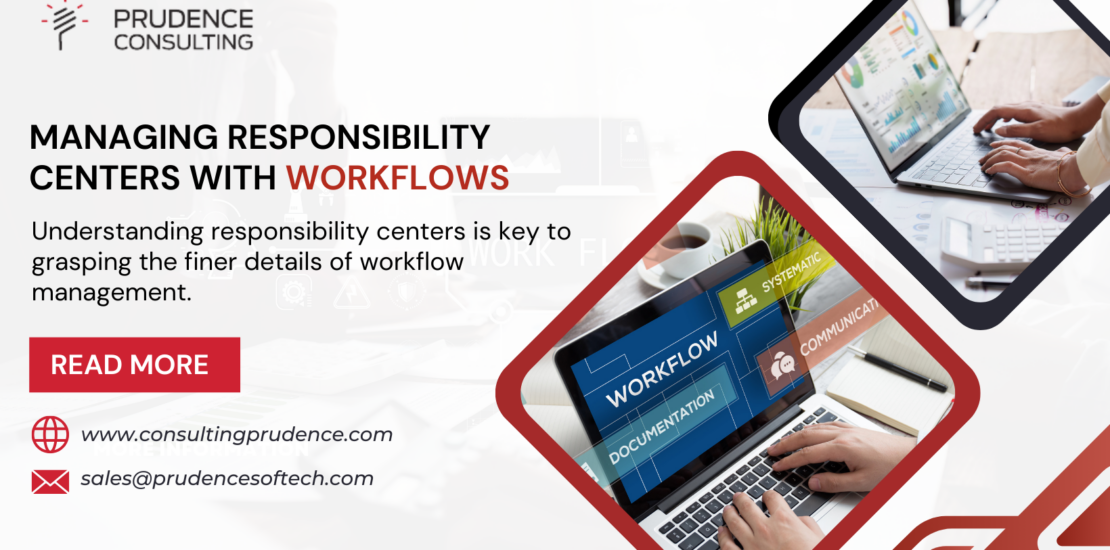Managing Responsibility Centers with Workflows
-
March 4, 2024
- Posted by: piyush.gupta@prudencesoftech.in
- Category: Workflow Management
No Comments

- March 4, 2024
- Posted by: piyush.gupta@prudencesoftech.in
- Category: Workflow Management


In the workplace, responsibility centers are like different teams or departments, each with its own job to do. Managing them well is crucial for a company’s success. That’s where workflows come in handy.
Before delving into the intricacies of workflow management, it’s essential to grasp the concept of responsibility centers. These centers are typically categorized into four main types:
- Cost Centers: These units are primarily responsible for controlling costs within the organization, such as administrative departments or support functions.
- Revenue Centers: Units categorized as revenue centers focus on generating revenue for the company, such as sales or marketing teams.
- Profit Centers: Profit centers are tasked with both generating revenue and controlling costs to maximize profitability. Business units or product lines often fall into this category.
- Investment Centers: These centers have the authority to make investment decisions and are evaluated based on their return on investment (ROI). Examples include divisions with significant capital investments or R&D departments.
The Role of Workflows in Management
Workflows serve as the procedural framework that guides the execution of tasks and processes within responsibility centers. By defining clear workflows, organizations can streamline operations, enhance efficiency, and ensure alignment with strategic objectives. Here’s how workflows contribute to effective management:
- Standardization: Workflows establish standardized procedures for carrying out tasks, minimizing ambiguity, and ensuring consistency across responsibility centers. This uniformity fosters clarity and enables employees to understand their roles and responsibilities clearly.
- Process Optimization: Through workflow analysis, organizations can identify bottlenecks, redundancies, and inefficiencies within responsibility centers. By optimizing processes, unnecessary delays can be reduced, and productivity can be maximized.
- Accountability: Clear workflows delineate the sequence of activities and the individuals or teams responsible for each step. This promotes accountability as employees are aware of their specific roles within the broader context of the workflow. Moreover, transparent workflows facilitate performance tracking and evaluation, enabling management to identify areas for improvement.
- Collaboration: Workflows often involve multiple stakeholders working collaboratively towards a common objective. By integrating communication channels and feedback mechanisms into workflows, organizations can foster collaboration among team members, enhancing synergy and collective problem-solving.
Implementing Workflow Management Systems
To effectively manage responsibility centers with workflows, organizations can leverage modern workflow management systems (WMS). These platforms offer a centralized repository for designing, executing, and monitoring workflows. Key features of WMS include:
- Workflow Design Tools: Intuitive interfaces allow users to create visual representations of workflows, defining process steps, decision points, and task assignments.
- Automation Capabilities: WMS automate routine tasks and notifications, reducing manual intervention and streamlining process execution.
- Tracking and Analytics: Robust reporting functionalities enable real-time monitoring of workflow performance, facilitating data-driven decision-making and continuous improvement.
- Integration Capabilities: Seamless integration with existing software applications and enterprise systems ensures interoperability and data consistency across the organization.
Conclusion
Effective management of responsibility centers is essential for organizational efficiency and performance. By implementing workflows strategically, organizations can optimize processes, enhance accountability, and foster collaboration within and across responsibility centers. Leveraging workflow management systems further amplifies these benefits, empowering organizations to adapt to evolving business dynamics and achieve sustained success in today’s competitive landscape.
In essence, the synergy between responsibility centers and workflows forms the backbone of organizational effectiveness, driving productivity, innovation, and growth. As businesses continue to evolve, embracing this holistic approach to management becomes increasingly imperative in navigating the complexities of the modern workplace.
Also Read : Dynamics NAV 2018 to Dynamics 365 Business Central


